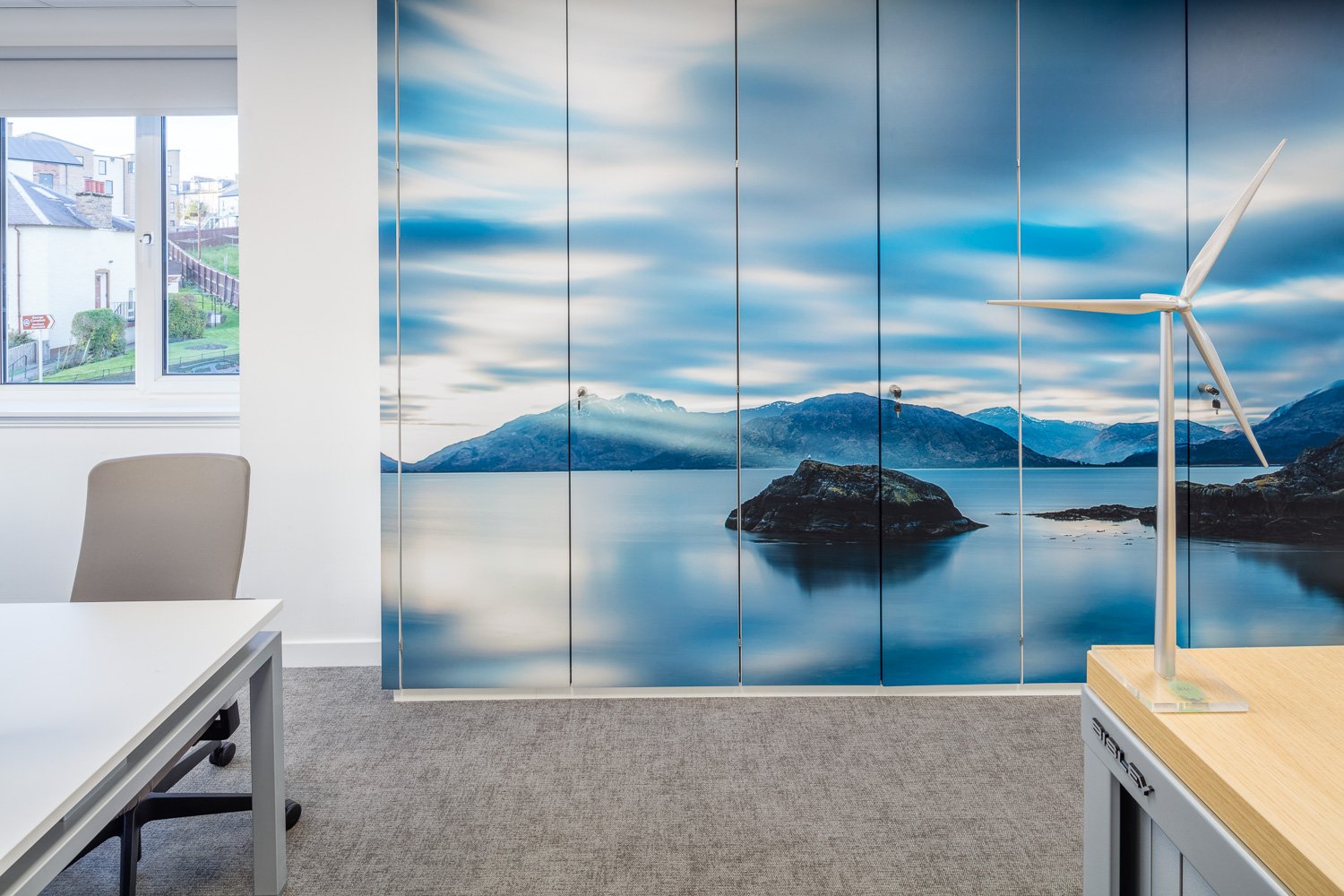Lease or Finance Options for your Office Fit Out or Refurbishment project
Is the Cost of Office Fit Out or Refurbishment too High to Pay Upfront in Full?
Undertaking a complete refurbishment or fit out of your office can be quite costly. However, it is also necessary. The right office furniture, style, design and “feel” of the office space altogether can transform your business for the better.
In other words, postponing or cancelling the refurbishment completely is not the best option for your business.
But what are you to do when budgets are tight and your company has cash flow issues?
At Amos Beech we love offering complete solutions to our clients. This is why we we work with registered lease providers who will be able to offer advice and flexible financing solutions. For an entire office fit-out, the cost can be spread over a 2 - 6 years term:
If you want an estimated guess on your project value, check our cost calculator.
Meet the Perfect Financial Solution for Your Office Fit Out or Refurbishment
When budgets are tight, but the project has to be completed, you typically have three options:
Bootstrap and pay everything upfront
Get a loan from a bank
Lease the project
Paying cash upfront is ideal if the payment won’t leave your company vulnerable. Plus, keep in mind that the total cost of the refurbishment or office fit out might exceed, the annual investment allowance (AIA) that went up from £200,000 to £1,000.000 in January 2019 and extended on April 1st 2023. Thus, you may not be able to offset the entire expense.
A bank loan can typically be paid between one and 10 years. You can deduct each payment against AIA, but the interest rates (that are subject to fluctuations) can make it hard for you to plan your finances for the long term. Plus, you run several other risks if the loan is tied to some of your crucial assets. Furthermore, a bank loan may not cover all the expenses related to your project.
A lease, on the other hand, can cover everything, from design and build to office furniture. You can also write the payments off as expenditure. And, since the payments are fixed, they are also easy to budget for. Your cash flow is protected since you don’t need a large deposit. You would lease purchase and only pay a token to transfer ownership at end of the payment plan.
The current lease conditions are quite flexible and friendly for Scottish businesses.
Why?
Because leasing is not yet as popular here as it is in the USA or other European states. However, as its popularity begins to grow, the advantages are likely to diminish.
How Leasing Unties Your Capital
Your capital is the backbone of your company. When you can’t make the investments you need, your growth is stalled. This is why it’s always a good idea to have a healthy cash flow and a healthy investment capital instead of tying it up in various assets and/or overdrafts.
Leasing your office fit out or refurbishment project can help you:
Stay liquid: no large initial payment means that your cash flow is not significantly affected and remains free to be invested in the next great opportunity that knocks at your door.
Budget accurately: unlike in bank loans, in lease financing your payments are fixed because they are not subject to interest rates. So you know exactly what you will be paying today and two years from now.
Keep your bank credit lines free: your bank overdrafts are unaffected, so you can always use them for investment opportunities.
Buy cheaper: leasing can actually be cheaper than paying for the refurbishment of your office upfront. Even if the project exceeds the annual investment allowance of £1,000,000, you can still deduct all your leasing payments.
Tax efficient: for private sector organisations leasing provides a highly attractive fully tax deductable solution. In addition to that the VAT is spread as it is paid on each repayment.
Stay flexible: the typical lease is between three and five years, but you can always opt for a personalised length of contract that fits your monthly budget and your needs.
Start your project quickly: bank loans and credit lines can take months to be approved. A lease financing can take as little as a few hours.
Who is it for?
Public sector: by spreading the costs, the projects can be delivered as and when they are needed most.
Charities: have a duty to trustees to make budgets work as hard as possible and get the VAT to spread, as most charities can’t claim the VAT back.
Professions: like doctors, lawyers, accountants, dentists and vets, but also partnerships are all subject to higher rates of tax and the tax benefits need to be explored.
Large Corporates: having lots of available capital doesn’t mean that you shouldn’t explore tax benefits. The available cash can then be used where it most benefits the business.
SMEs: with the saved capital, new people can be recruited to grow the business.
Don’t Postpone Your Office Fit Out and Furniture. Be Smart about it Instead!
At Amos Beech, we know a lot about how office interiors can shape and transform your corporate culture. From better acoustics to switching to activity-based working, we’ve seen seemingly minor improvements bring great results.
This is why we have partnered with the top lease financing company in the country to offer you the flexibility you need to reap the benefits of office refurbishment and fit out NOW, not in a couple of months or years.
Wellbeing, Wellness & Workplace
The blog below was written way before the current Covid19 crisis. It is not that the information is not valuable anymore, but if you require advice for the current (May 2020) situation, we would advice you to check the folowing:
Wellness is now BIG business! It moves you one step closer to a new, and better you - a you that drinks green juices and rids your body of all lingering toxins, a you that enrolls into spin classes before 6 am and has more energy as a result, a you that plugs into head space every evening to calm the mind before your 8 hours of sleep.
For the past month at Amos Beech, wellness has been at the forefront within the office. By being provided with a conscious checklist, we've become more self-aware of our actions and routines within our lifestyle and how it affects us in the workplace.
Wellbeing & Wellness in the Workplace
Here are a few insights and examples that you can try to integrate into your workplace to get the Work/Life balance back on track:
Outside, Inside
Since our blog about Biophilia within the workplace, in 2017. We've all seen workplaces flourishing everywhere. But how about having greenery with a purpose? At Takahashi Hiroko, based in a former factory in Tokyo, redesigned by schemata includes an indoor garden with edible plants.
Fresh Foods
With your office-grown ingredients to hand, having healthy food options will fuel your employees and keep their cravings for sweet and fatty foods away. Even as simple as sharing good food at a decent table will work wonders for your firms' staff morale and community feel.
Workout While Working
Many Japanese corporations understood early on the importance of exercise for their employees. It grew out of their philosophy of kaizen, or “continual improvement.” They appreciated that a workout could make their employees healthier and more productive, therefore began to schedule exercise programs during work hours.
We suggest dedicating a bit of space to being 'multi-use' area, where a variety of exercise classes and wellness workshops could take place. Consider offering something different from the standard yoga, perhaps something that also encourages teamwork. But if space is limited, try getting your employer to take a step in the right direction by contributing towards a gym membership or cycle to work scheme.
Personalised Technology
In other news, Scotland's first development has been accredited with a Platinum WiredScore Certification at 177 Bothwell Street, Glasgow, to assure future occupiers with the best connectivity. We've seen more products beginning to appear that allow employees control over their surroundings, but also products that understand and adapt to the needs of the employees throughout the day.
Philips has installed a system of LED lights in an office in Prague that fluctuate to the circadian rhythms of employees from morning through to night. This ideal is reminiscent of the Endless House, a conceptual work of architecture by Frederick Kiesler in 1924; “endless like the human body—there is no beginning and no end to it.” In the future, we will see smart buildings understanding the needs and wants of the inhabitants and adapting seamlessly.
Healthy Workstations
Until that point, we've seen a rise in technology being incorporated into furniture items keeping employees staying connected with air-charging and USB points. These small details make life just that little bit easier on the most stressful of days. Even by giving employees a choice with their desking, implementing sit-stand desking is more comfortable and healthier for the body.
Art for All
The Sculptor Nick Hornby past artist-in-residence was in an unlikely location - the London headquarters of law firm Pinsent Masons. He brought lawyers to his studio and curated his artwork around the office.
The art can play a part in the culture of the workplace, representing a set of shared attitudes, values, goals and practices. As well as being thought-provoking and sparking discussions with other staff members.
A Daily Pause
In Kiev, the Grammarly Office has a dedicated nap room that includes three sleeping blocks, with a weight sensor under the mattress that sends a signal to light with the indication of zZZ letters outside. The power of sleep and quiet reflection is becoming more commonly recognised as valuable, great opportunity to allow your mind and body to relax.
Happy Holidays
And we all know that a holiday is the best occasion to really relax and rebalance oneself. How about providing your employees with a 'wellbeing day' or have their birthday off on top of the standard holiday allowance to show your appreciation. Or go the extra mile, like FormRoom they are proud to offer a one month (fully paid) sabbatical for every 3 years your stay with their team. They reiterate the value of 'Let the company you work for, lift you up and push you forward; not drag you down or hold you back.'
Do you want to read more about how to improve your workplace? Check:
Blog and graphics by: Design Team
Publication date: August 14th, 2019
What Is Activity-Based Working ?
In simple terms, activity-based working or ABW, refers to providing employees with a location choice. This means that employees get to choose a location that is most suitable for them to work from. They do not have a designated workstation, but the workplace has several areas where they can do specific tasks like focusing, socialising, collaborating and learning.
Today’s workplace has been transformed by technologies like laptops and mobile phones. These have made workers more productive by freeing them from their desks. People can work from anywhere due to their ability to access information easily from the cloud.
Business models as we used to know them are also being disrupted today and new approaches geared towards making employees more flexible and productive are needed. Activity-based working is one of these business models that provide workers with options tailored to their needs.
The driving principle behind the activity-based workplace design is that offices should be flexible enough to adapt to the diverse tasks performed by employees. Traditionally, employees were assigned a single workstation. In the activity-based workplace, employees can move around depending on the task at hand. The flexibility is built into the company’s physical office through its culture, spaceplan, workspaces and furniture.
For example, an employee can start her morning with a brainstorming session at the coffee bar, then move to a conference room for a client meeting and then move to a more private workstation to make calls and work tasks that require extra focus.
ABW @ MRI Software in Newcastle
In this case, she has no fixed desk and can move around freely to the area that provides the best environment for the activity she is handling. All she needs is her mobile phone, a laptop, and a company network.
What exactly does activity-based working bring to the table for both the company and the employees? Let’s see!
6 Undeniable Benefits of Activity-Based Working
Improves Collaboration and Communication
In an ABW environment, employees from different departments can easily collaborate on tasks and projects. This increases productivity and output since they are no longer tied to a desk all day.
Team members can seamlessly move around the workspace. In turn, this leads to better communication, easy sharing of ideas and more. This is the perfect setting for innovative ideas to be born.
Attracts and Retains Good Talent
Adopting a dynamic workplace helps engage staff, stakeholders, and visitors. You can attract the best talent by providing them with something that others don’t – unparalleled flexibility and freedom. Existing employees are also likely to stay if their workspace meets all their needs both personally and professionally.
Boosts Concentration
An activity-based office has workspaces designed for specific tasks. These can include focus group areas, collaborative zones, and quiet places.
Such spaces allow employees to be alone when they need to and to sit comfortably with their colleagues when team work matters the most. Everyone works differently. Some thrive in large crowds, others need to be alone to get their best work done. This is what activity-based working is all about.
Increases Productivity
Traditional offices have been designed for desk work and meetings only. But an activity-based workspace will allow employees to choose how they work, when and where. This recognition of the difference that makes every employee important empowers them to be responsible for their work and decide where they want to work from and when.
Builds Trust
Employees get a sense of ownership, which makes them build trust in the organisation and vice versa. This ultimately leads to company and brand loyalty.
Boosts Flexibility and Sustainability
Letting your employees choose where and when they work can help them balance their personal and work lives, which, in turn, can improve the overall employee wellbeing.
Activity-based working is the sustainable way to grow. Since it’s better at using office space than the working styles, it will help you save a lot of money on real estate. Plus, it reduces the company’s carbon footprint through cutting down on energy and supplies in the office.
Activity-based working also gives you the flexibility to incorporate custom office furniture. Get an interior design expert to recommend the right furniture to support your new working environment.
Activity based workplace design at MRI Software Newcastle
Before you dismiss it as “a new trend that will never catch on”, let us tell you that activity-based working has been around for some time now. And it’s not going anywhere.
A lot of research has been done on this topic. It all proves that it has unlimited benefits for employers and employees alike.
Of course, activity-based working is not without its challenges. They have also been exhaustively researched and documented. Read on to find out how to overcome them.
But first, let’s take a look at some of the most prominent studies.
Research on Activity-Based Working
In a survey of 400 multinational companies, two-thirds of them were open to implementing the shared desk workplace by the year 2020.
Before jumping to it, a lot of companies wanted to learn their employees’ take on the matter.
A recently published study tried to find out if 1000 Australian employees were okay with shared desk environments. Some of the challenges highlighted by the surveyed employees include distractions, increased distrust, negative relationships, uncooperative behavior, and a perceived distrust of supervisors in terms of support.
Another report on hot desking, which shares the activity-based workspace principle, identified challenges like indifference, marginalisation of employees, loss of identity, decreased commitment from organisations, and inattention to co-workers.
However, let’s take a look at the broader picture.
The activity-based workspace design provides different work settings for various activities like private work, meetings, collaborations, creativity, and concentration. The employees are, therefore, expected to make switches between the settings when necessary.
When asked how they feel about a new concept, most people shy away at first. This is why it’s important to test out an office setting before committing to it. Or, better yet, to make the change gradually.
Companies like Facebook and Google are at the forefront of innovation in this field. They adopted activity-based working “before it was cool” and never looked back.
Why?
Well, the reasons are numerous.
To begin with, in hot desking, employees share desks or find one when they need it. This caters well especially to employees who work outside the office often. Another plus side of using hot desking is that there are hot-desking apps available to help in the booking of space before arriving at the office.
In today's smart offices, hot desking applications such as the app marketed by iOt Space now enables employees to choose and book their desks in advance. This app helps avoid the confusion that could arise in case two people want to sit at the same desk. The apps help one find an available desk and they also navigate you to the desk with no delay, especially if you are visiting the office from out of town.
Office layout showing workspace occupancy
This way, some of the challenges that the studies above found are simply non-existent.
Positive research, however, has shown that employees who have self-contained work processes and who view themselves as independent and mobile thrive in activity-based work environments. They can therefore easily choose a workstation based on their preferences or needs. Another positive is that they can avoid social interaction when they need a quiet space to work from.
Its supporters say that the main reason companies implement activity-based working environments is to attract and retain talent. They also wish to take care of their employees’ sustainability and wellbeing while increasing innovation and collaboration.
Based on the various research findings discussed above, we can conclude that there is no one size fits all solution. ABW and hot desking will increase collaboration, efficiency, and communication but it will come with its own challenges.
Of course, any challenge can be surmounted. Since every company is unique and has unique needs, you shouldn’t necessarily base your decision on research done on other companies.
You can use such reports as a way to get started. Afterwards, you should consider your own circumstances.
Factors You Should Consider Before Implement Activity Based Working
Think about it this way: the way people work changes throughout their life. It’s only natural that they can accommodate (and even expect) an evolution of their working environment.
During the school years, everyone knew a certain space was dedicated for a certain activity. There was no in-between. For example, the music room for music, the gym for sports and the laboratory for science.
When they got into a university, they had the choice to either get the group work done under a tree, at the café, or in the library. A traditional workspace may therefore not work for them. Organisations have no choice but to embrace these new ways of working if they want to retain and attract new talent.
Before making the change, however, employers have to consider some important factors including:
What Are the Reasons for the Change?
Why do you want to implement activity-based working? Are you doing it because everyone else is? Do you feel like your peeps could benefit from more interaction?
Activity-based working encourages collaboration and therefore your business can easily pull a team from different departments in your organization to work on a project if everyone is mobile. Employees are different, and this difference is what makes activity-based working a good model.
Those who require isolation can work at their own stations while those who thrive in a noisy work environment can also do their thing. It encourages responsibility. More importantly, employees are treated as adults who can choose an environment that makes them productive.
Before making the decision, consider your employees. Ask them how they feel about it.
Make Sure Your C-Suite Supports the Move
If they do, then they will offer you support and advocate for the chance by leading by example. Otherwise, everything may be doomed from the start.
If your employees see that C-level execs never step foot in the common workspace, they will feel discriminated and treated as less important.
Of course, we all know that C-level execs need privacy. But they also need to be among their team every once in a while, don’t they?
Choose the Best Model for Your Team
As previously mentioned, there is no one size fits all when it comes to designing your office. Do a thorough research on the different models available and then choose one that suits your organisation’s needs. Obiously you can ask the workplace consultants here at Amos Beech for help.
Take Change Management Seriously
As you invest in this move, make sure your employees are educated on why the move is necessary, the benefits of the move, what will be changing, and why this particular model has been chosen. Use an effective communication plan that will involve different mediums and engage employees at all the levels of the organisation.
Test Drive before Purchasing
Test whether the change will be effective using a pilot workspace. This is an effective change tool because, from it, you can tell whether the move will benefit the company or not.
The pilot will also be a learning phase that will help you tailor a suitable working model as per your needs. Plus, it will help the employees warm up to the new way of doing things and how it will eventually affect them.
Don’t Be Discouraged by Negativity
Change is hard and some of your employees will not be thrilled by it. Learn from them but do not let them bring you down.
Recruit the Right People and Rid the Company of Paper
Activity-based working can enable you to manage all your records electronically. This will reduce your carbon footprint and turn you into a more desirable employer and business partner for your clients.
Also, make sure you recruit leaders with skills and expertise in activity-based working so they can help other employees easily adapt to the new move. Safeguard your investment by choosing the right people to handle it.
Final Thoughts
According to a case study by UK’s HR Magazine on Atlas Copco’s introduction of activity-based working at their UK office, the exercise proved to be successful.
The company implemented a cockpit for individuals needing privacy, a larger cabin that allowed for small groups to work together, and an open space furnished with multiple desks. This gave them a digital workspace that can be reconfigured whenever the needs of an employee change. The employees are now more connected and engaged since their working conditions have changed for the better.
Activity-based working benefits may not be felt immediately, but they are broader and long-term. And if they are properly executed, they can foster the wellness of the employees by improving their mental, physical, and social wellbeing.
Got 4 minutes?
Go and watch a really great video! Veldhoen + Company have created a great animation about what Activity Based Working is and what it isn't:
Most important takeaway:
"Whats really needed is a workplace tailored to the actual needs of people.”













































